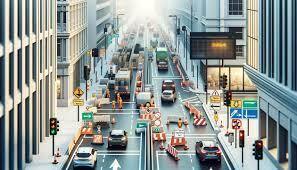Traffic and Access:
Ensuring Smooth Traffic Flow with a Comprehensive Traffic Impact Study
At Unified Studio Architect, we know that one of the most critical components of any successful construction project is ensuring safe, efficient access to and from the site. Whether you’re developing a residential neighborhood, commercial property, or a mixed-use development, the way traffic flows around your site can make or break the project’s success. Traffic flow not only affects the efficiency of your site, but it also plays a key role in the safety of drivers, pedestrians, cyclists, and public transportation users.

One of the common requirements we encounter during the design review process is the need for a Traffic Impact Study (TIS). This detailed analysis is essential in understanding how a new development will impact surrounding roadways, traffic patterns, and the overall transportation network. The study identifies potential traffic issues, such as congestion or safety concerns, and offers solutions to mitigate these challenges before they can affect your project.
In this post, we’ll explain why a traffic impact study is necessary, walk you through the steps involved in conducting one, and explore how we work with traffic engineers to refine your site design based on the study’s findings.
Why Is a Traffic Impact Study Required?
A traffic impact study is a comprehensive analysis that evaluates how a new construction or development will affect local traffic conditions and the infrastructure that supports them. Municipalities and local authorities often require this study before granting development approval. The study’s primary purpose is to identify any potential traffic-related issues and determine if additional infrastructure improvements are needed to handle the increased traffic demand.
Key factors that are evaluated in a traffic impact study include:
- Traffic Volume: How many vehicles are expected to enter and exit the site each day, particularly during peak hours?
- Traffic Flow: How will the added traffic affect local roads and intersections? Will there be congestion or delays?
- Safety Concerns: Are there any new risks due to added traffic, such as accidents, bottlenecks, or poor sightlines?
- Public Transportation: How will the project affect existing public transit routes, stations, or infrastructure?
- Pedestrian and Bicycle Access: Will the development impact walking or cycling paths? Will additional infrastructure be needed to accommodate non-motorized traffic?
Municipalities require traffic impact studies to ensure the local transportation network can handle the new development without compromising safety, efficiency, or the overall user experience. It also ensures that developers implement necessary improvements to mitigate negative impacts on the surrounding area.
The Process of Conducting a Traffic Impact Study

A comprehensive traffic impact study involves multiple steps to assess the current conditions, predict the effects of the new development, and recommend solutions to manage traffic flow. Let’s take a look at the key stages involved in the process:
1. Data Collection
The first step in the traffic impact study is to gather baseline data about the current traffic conditions in the area. This includes:
- Traffic volume counts: Conducting surveys to determine how many vehicles pass through nearby intersections during various times of day, including peak periods.
- Traffic patterns: Analyzing turning movements, congestion points, and common traffic flow routes.
- Roadway infrastructure: Reviewing the current infrastructure in place, including turn lanes, traffic signals, and pedestrian access points.
2. Traffic Projections
Based on the project type (whether it’s residential, commercial, or mixed-use) and its size, traffic engineers will estimate how much additional traffic the development is likely to generate. Projections are based on:
- The size of the development (e.g., number of units in a residential area or square footage of commercial space).
- The types of uses (e.g., offices, restaurants, retail stores, etc.).
- Expected occupancy rates and average vehicle trips per unit or business type.
3. Analysis of Traffic Impact
Once data has been collected and projections are made, engineers will analyze the potential impact of the new development on surrounding roadways and intersections. Key focus areas include:
- Roadway capacity: Will the current roads be able to handle the increased traffic volume, or will upgrades such as road widening or additional lanes be necessary?
- Intersection analysis: Will nearby intersections experience delays or bottlenecks? Can they handle the increased demand without causing gridlock?
- Safety analysis: Are there existing or potential hazards, such as poor sight distances, sharp curves, or high-traffic areas that need to be addressed?
This phase of the study helps determine the specific areas where improvements are required to ensure smooth traffic flow and public safety.
4. Recommendations for Mitigation
After analyzing the potential impacts, the traffic engineer will provide a series of recommendations to mitigate the effects of the new development. Common recommendations include:
- Adding turn lanes: At intersections or driveways to reduce congestion and allow smoother entry and exit.
- Installing or upgrading traffic signals: In areas where traffic flow needs to be better regulated or controlled.
- Improving sight distances: By adjusting the placement of driveways, trimming vegetation, or repositioning signs to improve visibility for drivers.
- Roadway widening: In cases where roads are not wide enough to handle additional traffic, or when bottlenecks occur.
- Pedestrian and bicycle enhancements: Installing crosswalks, bike lanes, or improving access points for cyclists and pedestrians to ensure safety and ease of access for non-motorized traffic.
How Unified Studio Architect Mitigates Traffic Concerns
At Unified Studio Architect, we collaborate closely with traffic engineers to ensure that the necessary improvements are incorporated into the site design. Once the traffic impact study is complete and recommendations are in hand, we adjust the design to align with the study’s findings. Below are several ways we mitigate traffic concerns and ensure smooth traffic flow:
1. Revising Site Access Points
Based on the study’s findings, we may need to revise the ingress and egress points to improve traffic flow and reduce congestion. These adjustments could include:
- Relocating driveways or access points to align better with traffic flow or improve sight distances for drivers.
- Adding additional turn lanes where necessary to allow smooth entry and exit points.
- Installing traffic signals or adding stop signs at critical intersections to control traffic movement and prevent bottlenecks.
2. Enhancing Site Circulation
For larger developments, the internal circulation of vehicles within the site is a crucial consideration. Based on the study’s findings, we can improve circulation by:
- Implementing one-way traffic systems to streamline traffic flow and reduce congestion.
- Designing adequate parking areas with proper traffic flow to allow easy entry and exit. We may also include designated drop-off zones for multi-use or commercial buildings to keep traffic organized and moving smoothly.
3. Improving Pedestrian and Bicycle Access
Safety for pedestrians and cyclists is just as important as vehicle traffic flow. Depending on the traffic impact study’s findings, we might incorporate:
- Pedestrian walkways to separate foot traffic from vehicle areas and reduce the chance of accidents.
- Bike lanes or bike racks where appropriate, to ensure that cyclists can easily and safely access the site.
- Crosswalks with proper signage to improve pedestrian safety, especially near high-traffic entry/exit points.
Conclusion: The Importance of a Traffic Impact Study
A traffic impact study is a critical step in ensuring that your construction project is successful and that it doesn’t introduce safety or traffic flow issues into the surrounding area. By carefully analyzing current traffic conditions and anticipating future impacts, we can identify potential problems and take proactive steps to mitigate them.
At Unified Studio Architect, we collaborate with traffic engineers to ensure that every aspect of your project, from site access to pedestrian and cyclist safety, is carefully considered. Whether it’s adding turn lanes, installing traffic signals, improving sight distances, or enhancing pedestrian access, our goal is to design a site plan that promotes safety, efficiency, and accessibility for all users.
If you’re planning a new construction project and need assistance with a traffic impact study, Unified Studio Architect is here to help. Contact us today to discuss how we can help you navigate the complexities of traffic management and bring your project to life. We’ll work with you every step of the way to ensure your development meets all necessary standards and provides safe, efficient access for vehicles, pedestrians, and cyclists alike.
